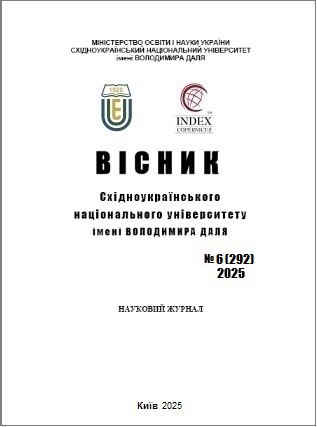Promoting employment in rural areas based on a bioeconomic model for the processing of medicinal plants
DOI:
https://doi.org/10.33216/1998-7927-2025-292-6-25-34Keywords:
bioeconomy, medicinal plants, employment, rural areas, added valueAbstract
The article explores the issue of stimulating employment in rural areas of Ukraine through the implementation of a bioeconomic model for the processing of medicinal plants. A comparative analysis of the traditional agrarian model and the bioeconomic approach makes it possible to identify the qualitative advantages of bioeconomy as a tool for employment diversification, reducing labor migration, and forming new segments within the local economy. It is substantiated that the bioeconomy ensures flexibility in production aimed at sustainable development and contributes to the increase of added value without significant reliance on external resources.
Applied technologies for processing medicinal plants are presented, including methods of primary and secondary treatment, which enable the creation of competitive products with a high degree of localization. A value-added chain structure has been developed, encompassing the stages of cultivation, harvesting, technological processing, packaging, and sales, with the involvement of the local population possible at each level.
The socio-economic potential of the sector is analyzed, including the creation of new jobs, the development of women’s entrepreneurship, support for youth, and the expansion of employment in small-scale production. Key barriers (lack of access to technologies, financial tools, certification, and markets) and opportunities (support from international partners, environmental trends, and availability of raw materials) for the development of the bioeconomy are examined.
The necessary preconditions for its effective functioning in rural communities are identified, including human resource potential, logistics infrastructure, educational initiatives, and mechanisms of cooperation. Institutional mechanisms to support the development of the bioeconomic model are also outlined, particularly through program-based funding, tax incentives, the involvement of advisory services, and the development of educational platforms.
Thus, the research results deepen the understanding of the practical aspects of bioeconomy as a factor of sustainable development, especially in the context of addressing socio-economic challenges at the level of rural communities.
References
1. Федина С. М. Формування біоекономіки в контексті забезпечення сталого розвитку : дис. ... д-ра філософії : 051 – економіка / С. М. Федина. Сумський держ. ун-т. Суми, 2021. 232 с. URL: https://essuir.sumdu.edu.ua/bitstream-download/123456789/86296/3/diss_Fedyna.pdf (дата звернення: 15.04.2025).
2. Пєчка С. С. Стратегії диверсифікації діяльності аграрних підприємств : дис. ... д-ра філософії : 076 – Підприємництво, торгівля та біржова діяльність / С. С. Пєчка. Одеський нац. технолог. ун-т. Одеса, 2024. URL: https://ontu.edu.ua/download/dissertation/phd/Disser/2024/Disser-PhD-Pyechka.pdf (дата звернення: 15.04.2025).
3. Vostriakova V. Bio-Economy of Ukraine: Efficiency and Potential for Development Based on SEE-Management Methodology. Environmental Research Engineering and Management. 2025. Vol. 81, № 1. P. 8–24. URL: https://doi.org/10.5755/j01.erem.81.1.38344 (дата звернення: 15.04.2025).
4. EU Bioeconomy Strategy. Bioeconomy for sustainable development. 2018. URL: https://commission.europa.eu/system/files/2020-03/bioeconomy_strategy_2018.pdf (дата звернення: 15.04.2025).
5. Tan E. C. D., Lamers P. Circular Bioeconomy Concepts—A Perspective. Frontiers in Sustainability. 2021. Vol. 2. Article 701509. URL: https://doi.org/10.3389/frsus.2021.701509 (дата звернення: 15.04.2025).
6. Nallapaneni M. K., Haque M. A., Patwary S. It Is Time to Synergize the Circularity of Circular Bioeconomy with Sustainability and Resiliency Principles. Sustainability. 2023. Vol. 15, № 16. Article 12239. URL: https://doi.org/10.3390/su151612239 (дата звернення: 15.04.2025).
7. Калачевська Л. І. Інноваційний розвиток сільських територій: наукові основи, стан та перспективи. Монографія. Суми: ФОП Литовченко Є. Б., 2019. 276 с. URL: https://repo.snau.edu.ua/bitstream/123456789/11217/1/%D0%BC%D0%BE%D0%BD%D0%BE%D0%B3%D1%80%D0%B0%D1%84%D1%96%D1%8F%20%D0%9A%D0%B0%D0%BB%D0%B0%D1%87%D0%B5%D0%B2%D1%81%D1%8C%D0%BA%D0%B0%20%D0%9B.%D0%86..pdf (дата звернення: 15.04.2025).
8. Кучер О. В. Біоекономіка як сучасна парадигма економічного розвитку. Bioeconomy and Agrarian Business. 2021. Vol. 12, № 2. URL: https://doi.org/10.31548/bioeconomy2021.02.002 (дата звернення: 15.04.2025).
9. Бугайчук В. В., Грабчук І. Ф. Біоекономіка та її роль у розвитку сучасного суспільства. Економіка АПК. 2018. № 5. С. 110–115.
10. Вожегова Р. А., Малярчук А. С., Котельников Д. І., Резніченко Н. Д. Сучасний стан, перспективи та напрями розвитку виробництва лікарських рослин в Україні. Таврійський науковий вісник. 2021. № 118. С. 57–66. URL: https://doi.org/10.32851/2226-0099.2021.118.7 (дата звернення: 15.04.2025).
11. Державна служба статистики України. Web-site. URL:https://www.ukrstat.gov.ua/

